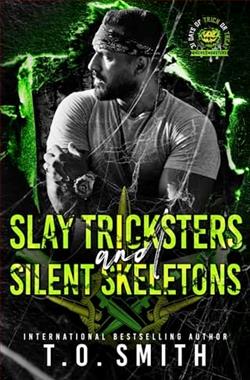Page 70 of The Texas Murders
“She’s agreed to let me interview her again,” Ava says. “Just me. I think I might be able to get her to open up if it’s just the two of us.”
“Excellent work,” Carlos says. “It was probably a mistake for Rory and me to be there the first time. Maybe what she needs is to talk to a fellow Tigua. And a woman.”
“And a friend,” I add, regretting that I shot down Ava’s original idea of talking to her one-on-one.
We don’t have time to talk anymore. I’m pulling up to the old community center already.
And I’ve forgotten all about calling Ryan Logan back.
CHAPTER 59
I DRIVE INTO a parking lot with weeds growing up through its many cracks. The building is a large, two-story adobe structure. The outside walls are as cracked as the parking lot and have been sporadically tagged with graffiti. Plywood sheets are nailed over the windows.
A temporary chain-link fence has been erected around the building, with tumbleweeds and garbage trapped in the links. The gate to the fence had been chained closed, but it looks like the chain has been broken by bolt cutters or a hacksaw.
I circle around the building once and note another panel van parked at the far end of the lot. We stop by it first, finding it unlocked but empty. But the presence of the van—Carpenter’s vehicle of choice—makes us think Carpenter might still be inside the building.
As we approach, we notice the entry doors had also beenchained, and those chains have also been cut and left lying on the sidewalk.
The front door squeaks as I swing it outward. Inside is pure blackness. The tile on the floor under my flashlight reminds me of my high school, the pattern outdated, the colors scuffed from wear. There is a front desk area and a bank of chairs bolted to the floor. The vinyl of the chairs is cracked and spilling stuffing. As I sweep my flashlight across the spiderwebs underneath the chairs, a black widow scurries into the shadows.
Carlos flicks a light switch, but nothing happens. No doubt the electricity was turned off long ago.
“Hello,” Ava calls out. “This is the Tigua Tribal Police and the Texas Rangers.”
Her voice echoes and is followed by silence.
“Come out with your hands up,” Carlos shouts.
No response.
I have a terrible feeling that, somewhere in the darkness, we’re going to find the body of Marta Rivera. We know Carpenter was at the casino then dumped the van ten miles away at Ascarate Park. The only reason I can think that he would have been here was to discard her corpse before switching vehicles. My mind imagines the worst—the young woman raped, tortured, even dismembered, left as a warning to us to back off.
“There are three floors,” Ava says, now keeping her voice to barely more than a whisper. “Should we split up?”
“Three?” I say, remembering only two from the outside.
“The ground floor. The upstairs. And the basement.”
The lobby splits into two corridors, which, Ava explains, creates a rectangular hallway going around the building. If we split into two groups, each taking a hallway, we’d meet somewhere in the middle. And whichever way we go, somewhere around the halfway mark, we’ll come to a stairwell leading up and down.
“Wait,” Carlos says, ducking down and shining his light closely at the floor. “Look at this.”
Ava and I kneel, as Carlos points out a faint footprint visible on the floor. A thin film of dust covers the ground and, if you look closely, you can tell that someone has walked through here. Now that we know what to look for, we shine our lights forward and see more of the boot treads recorded in the dust from when their owner walked deeper into the facility.
We shine the lights at our own footprints, which look similar, suggesting that the other prints might not be much older.
“I think these tracks are new,” Carlos says, his voice barely more than a whisper.
“Let’s follow them,” I say, keeping my voice down. “Together.”
Ava points out that there are tracks going in, but none coming out. Unless he found another way out, Carpenter or whoever else broke into the community center is still inside.
The three of us proceed as quietly as we can into the darkness.
Carlos and Ava lead, side by side, with me in the rear, checking behind us. Our boots make noise on the floor, but we are as quiet as we can be.
Chunks of plaster have fallen off the walls, and a few of the rectangular panels in the ceiling have dropped to the floor, exposing wiring above us. The boot tracks lead in and out of doors, as if the intruder was looking for something. One room contains old tribal decorations stacked against one wall: banners and costumes and drums. Another is used for the storage of old archery equipment: large hole-strewn circular targets along with bows and quivers of arrows leaning in the corner. Another room holds sports equipment, including a rack of deflated basketballs and a wrapped-up volleyball net. A trampoline is folded in half and shoved up against the wall, the canvas fraying and many of the rusty springs hanging loose.















